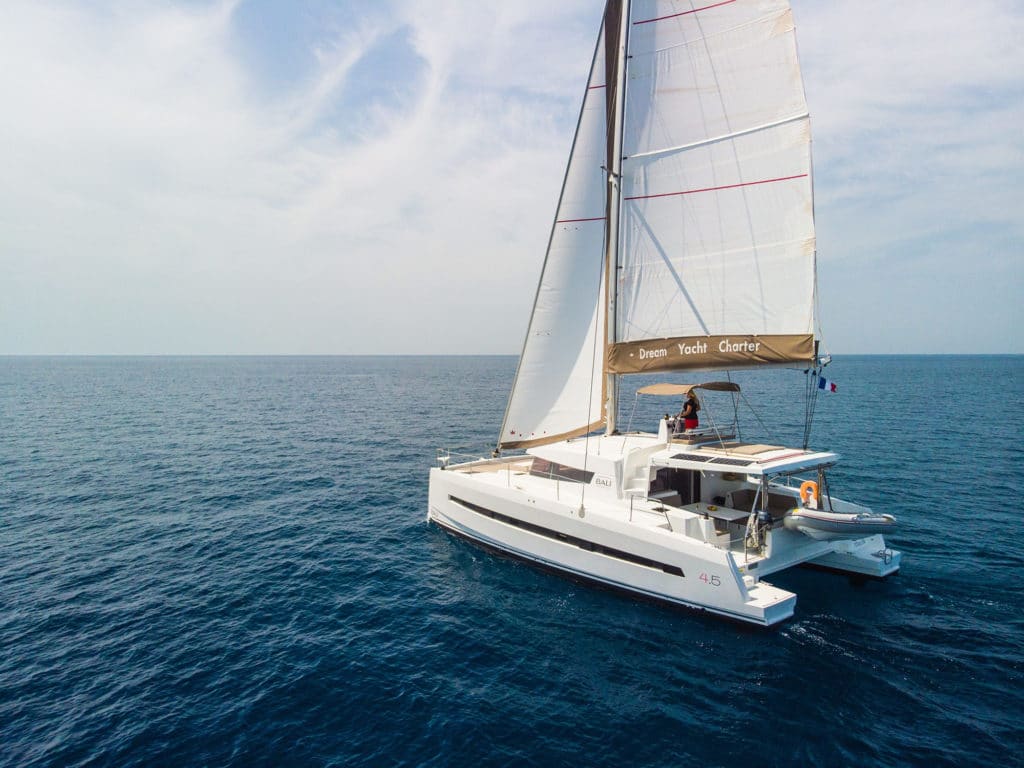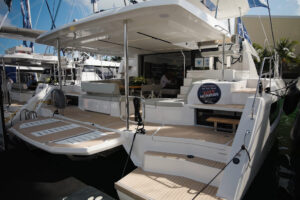
Ask any seasoned sailor, and they’ll likely tell you their favorite memories are tied to their boat. But boats are also a lot of work, and no one ever has called a private yacht cost-effective. For this reason, many owners choose to put their boat to work by placing it in a charter management program.
“There’s a huge economical advantage. But there’s a cost as well; a lot of people will be on the boat,” says Bruno Lemieux, who works in yacht sales, operation and development for Dream Yacht Sales.
Boats can be in Dream Yacht’s charter programs for up to 5 1/2 years, and the No. 1 question prospective owners have is:
What will my boat look like in five years?
A charter boat works hard, up to 33 weeks a year, in order to pay for all its expenses plus generate revenue for its owner.
“Yes, it will get some wear and tear for sure” says Yanik Aubé, Dream Yacht’s America and North Caribbean sales director. “But any boat just sitting at the dock gets damaged—by neglect, salt air, or even by just rubbing on the dock… In this case, damages will be fixed by the base, and you don’t have to worry about it. You have a team that’s going to do it. And instead of paying $90,000 to $100,000 a year for insurance, dockage and maintenance, those are paid for you. Plus, you receive 8 percent of your boat purchase price per year in revenue in some of our programs.”

When the yacht nears the end of its service, Dream Yacht does a phaseout to return it to the owner in good condition.
“About 30 days before the end of the contract, we start building a list of things that need to be repaired. The contract is clear that everything needs to be working. All the equipment on board that was there at the beginning will be there and working, and all the original inventory will be matched. The gelcoat will be done; the bottom paint, if not done within the last 12 months, will be done; sails will be refurbished,” says Lemieux, who was in the owner-care department before sales.
He explains that the contract covers all this and is quite straightforward. What is not covered is normal wear and tear for cosmetic items such as cushions. If any cushions are missing or torn, they will all be replaced per the matching inventory stipulation, but if they are simply worn, they will not be.
“I’ve been through about 25 phaseouts in the last year, and I have to say, Dream Yacht is doing a very fair phaseout. When the boat stops, they really spend the money and time to make sure the owners are leaving with a well-maintained boat,” Lemieux says.

So, is it worth it?
The yearly return of 8 percent of the purchase price that Aubé quoted is Dream Yacht Sales’ guaranteed income program, called Dream Guarantee. It more than covers the depreciation of the boat. After 5 1/2 years in charter, about 45 percent of the purchase price has been paid back to the owner.
Dream Yacht also offers a shared-revenue plan called Dream Performance, where charter income is split, 35 percent to the company and 65 percent to the owner. But the owner also pays for all expenses, the big three being dockage, insurance and maintenance.
In real numbers, historical data has shown that after commissions and expenses are paid, if a boat is chartered at least 22 weeks a year in the Performance program, the owner receives an average of 30 percent of all gross charter revenue. “So, if your boat generates $180,000 in revenue, you can expect to get around $54,000 in your pocket at the end,” says Aubé.
With some of the management programs offered by Dream Yacht Charter (Performance or Performance Plus) you can factor in the potential tax advantages of buying a yacht as an investment, which can be up to 35 percent of the purchase price, depending on the purchaser’s tax bracket, making the figures even more compelling. “In many situations, up to 90 percent of your boat gets paid (after charter service), and it’s still worth a lot more than that,” says Aubé.

How will my boat be maintained?
In the Dream Guarantee program, the company is responsible for and pays for everything. “If an engine blows, we will not call the owner; we’ll just replace the engine,” says Lemieux. After all, it’s in Dream Yacht’s best interest to keep the boat in good working order. In addition, a yearly maintenance period, including haulout, is built into the schedule.
The company also handles all repairs and maintenance items for Performance program yachts, but it will consult with the owners first because, of course, the owners are paying the bills.
In the works is a new platform that tracks maintenance, hours and parts for owners in both programs. “Owners will have access to this app in real time and know exactly what’s being done every day. It’s currently being tested in the Med in France and will be launched in America at the end of the year,” says Aubé.
Can I choose where it is based?
Yes—for owners of Performance yachts. “They can decide, ‘I want my boat in Annapolis during the summer, and I want it in BVI in winter.’ No problem. You’re covering the cost, you get the revenue, so you make the decision,” says Aubé.
In the Guarantee program, the boat is promised a region rather than a specific base. “If you say, ‘I would like my boat in the BVI,’ we will put it there and try to keep it located there, but it might have to be moved to another base if demand fluctuates,” Aubé says. In this scenario, the yacht would stay in the northern Caribbean region of the USVI, BVI and Bahamas. “We are the one who decides if it needs to be moved, but we will always work towards having the boat where the owner wants it to be at first.”

When can I use my boat?
In the Dream Guarantee program, an owner can sail up to 12 weeks a year, paying only a nominal cleaning/turnaround fee. Moreover, they can use these weeks on their own boat or on any similar model in Dream Yacht Charter’s 45-plus locations around the world.
It’s phrased “up to” 12 weeks because it’s seasonally dependent. Owners can book in advance either two weeks in high season and two weeks in low season, or six weeks in low season, plus they can book six weeks in high or low season last minute, meaning 10 days out.
In the Dream Performance program, owners can do what they’d like on their own boat. “There’s basically no limit of usage. So, if the owner wants Christmas, that’s fine,” says Lemieux.
A charter management program isn’t for everyone. An owner who doesn’t want to share their boat, expects it to be exactly as they left it each time they return, or enjoys tinkering on it every weekend is not a good fit for charter. But for those who are easing into boat ownership—perhaps slowing down on work commitments before the quintessential “sailing off into the sunset”—charter service can be a smart path. Not only does it make sense economically, but it also gives owners time to get to know their boat and gain sailing experience with the safety net of having a professional team looking after their boat.
Learn more at dreamyachtsales.com.








